We owe it to ourselves to walk (in stages, not necessarily consecutively) the entire route from home to the places we travel routinely.
By Mark Fenton
Published January 24, 2007
So the city became the material expression of a particular loss of innocence - not sexual or political innocence but somehow a shared dream of what a city might at its best prove to be -
- Thomas Pynchon, Against the Day
For a long time I used to take my eldest daughter to the Hamilton Gymnastics Academy located in the Ancaster Business Park. The classes were an hour and a half long and I couldn't justify the environmental damage of driving the two legs home and back again.
A better father would have gotten ongoing joy from watching his daughter prance along balance beams, tumble safely across mats, bounce across a trampoline like Tiger from Pooh, climb a rope to the gymnasium's summit like a marine in training. I watched and enjoyed some of this; but I also explored the region surround the HGA.
I believe we owe it to ourselves to walk (in stages, not necessarily consecutively) the entire route from home to the places we travel routinely, such as work or weekly activities.
I can't claim to have done it with every job or weekly activity I've had, but I fill in the blanks where I can. I'll admit this poses some challenge to the person residing in Dundas and working in North York. (But Oboy, is that ever an RTH travelogue I'd love to read!)
The first time I had to go to the HGA I was introduced to the ABP by passing between symmetrical signs. Here's the one on the left.

Ancaster sign
Depending on my mood, the sign looks like an arrow embedded firmly in the earth and it's tail to the sky; or else a baby bird, beak ajar, demanding food from its mother, both of which readings are apt enough metaphors for commerce and personal livelihood.
What intrigues me on a more literal level is that when I first came here, the concrete sign had the words 'Business Park' beneath the word 'Ancaster'. If you look carefully you can see the abrasion of these letters on the concrete just below the single horizontal plane of the sign's edge. The message has therefore changed.
Once this was a self-contained pocket of Ancaster: a set of buildings -strictly business -within the larger set of buildings -business and residential -which constitutes the community of Ancaster. It is no longer distinguishable as such. This is the entrance to Ancaster period. This is the future.
![Map to Ancaster [Business Park] Map to Ancaster [Business Park]](/static/images/ancaster_business_02.jpg)
Map to Ancaster [Business Park]
The easiest way to the A[BP] is to get onto Wilson street and follow it south-west, pretty much as far as you can go on it and still be in Ancaster.
You will pass the HGA on Wilson Street, but unless you feel secure in dropping your daughter there, having her cross four lanes without a light, run down and then up the walls of a damp ditch, and finally cross the parking lot into the HGA, you'll probably want to drive the several hundred metres beyond it, turn, pass between the gates of A[BP] (see above) onto Tradewind, take the first left onto Sandhill, and follow slow curves along Sandhill, an elaborate route through the very heart of the A[BP].
I really recommend it on foot. A new skyline will reveal itself every 20 metres or so.
Public Transit is an option, but if you're planning it, you probably want to head down the night before and position yourself at Motel Maple Farms, with its comfy rooms.
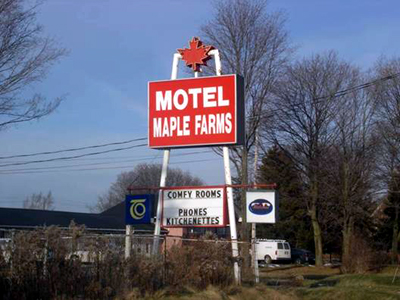
Motel Maple Farms
Pack some groceries for a late dinner, and maybe even splurge in the morning at breakfast at The Egg and I, directly across from the sharp fork of Garner and Wilson. There's a ditch there, so I'd recommend all-purpose footwear.
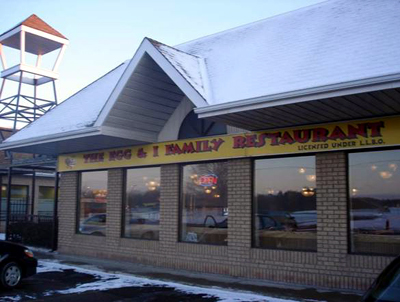
The Egg and I
In terms of selling the overnight A[BP] adventure to your child I have no personal experience, so I had to imagine a dialogue leading up to it.
Mother: Why don't we do something a bit different for getting to your Gymnastics lesson tomorrow? Break the quotidian. Have some fun.
Daughter: Okaaaayyy?
Mother: Here's my idea. We can take the Ancaster 16 right to Wilson and Garner. Then we'll check into Maple Farms Motel which is right there! I've already called. They have vacancies! We'll maybe even stay up a bit later and play Backgammon and then in the morning we can sleep a bit later than we normally would and have a breakfast at the Egg and I.
Daughter: [her attention completely diverted now from playing Sims on her computer. She is looking directly at her mom as though she needs to understand every nuance of this argument to formulate whatever plan it takes to get out of this ridiculous attempt at what, for her, is a lame piece of suburban performance art] Are... um... are you still having issues with Dad leaving? [very long silence] Why can't you talk to a therapist instead of reinventing us as alternative family. ['al-ter-na-tive-fa-mi-ly' stretched and broken by sudden sobs]
Mother: [Ignoring her] After breakfast it's just a quick walk down an escarpment - bring your boots it could be mucky! - and we're there on Sandhill. [presenting Daughter with the map at this point] We'll save on fuel, and the best thing about it is that we have mother-daughter time.
Daughter: [Stopping the crying rather suddenly during this next outburst. Just angry now.] Why can't we just have a vacation in Costa Rica like Malory's family! You're never going to finish your Urban Geography PhD. You're just play-acting at fieldwork!
Mother: LISTEN. It's nothing ABOUT my Urban Geography PhD! IT'S ABOUT KNOWING YOUR COMMUNITY. AND HELPING FIGHT GLOBAL WARMING!
Daughter: I HATE YOU; YOU'RE MEAN!
Mother: FINE. BUT WE'RE DOING THIS EVEN IF I HAVE TO MAKE YOU AND YOU'RE GOING TO LIKE IT!
Like I say, this scenario is just invented. The pitch to your child could be completely different.
At the time of my daughter's training I had not yet discovered the ease of camera technology for capturing moments observed experience - which makes this as good an opportunity as any to thank my Mother and Father for the camera they gave me so that I could do these essays. I toyed with the idea of including a photo of them in this essay since I've long had an inexplicable attraction to the habit of filmmakers like Martin Scorsese -
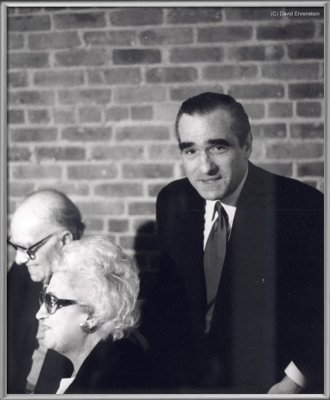
Martin Scorsese and his Parents, Luciano, Catherine and Martin Scorsese (Image Credit: Ehrensteinland)
- and John Cassavetes -
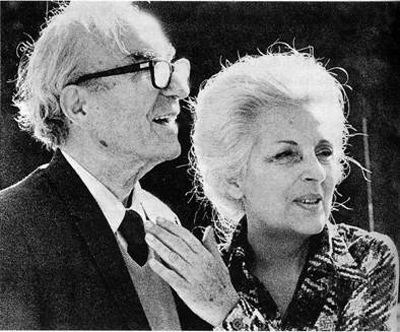
Nicholas and Katherine Cassavetes Ray Carney: Cassavetes on Cassavetes, Faber & Faber, 2001
- who frequently cast their parents in their films. I think this creates a palpable intimacy, while simultaneously setting a comfortable artistic distance between the viewer and the film. It's like being a guest at someone else's family gathering.
At the risk of perpetuating stereotypes, I worry that it would seem forced in someone like myself, from an Anglo Saxon culture, while it feels perfectly natural with these guys from Mediterranean cultures. Also, I'm not sure I've taken a photo of just my parents with the camera they gave me, which would be the way to do it.
So realizing I would have an hour and a half on my hands every Saturday morning, and not having engaged in visual art since the early years of grade school, I decided to document A[BP] by sketching.
I went to an art store and purchased pencils and sketchbooks with no knowledge of what materials would best meet my needs. I had no help from the art store staff, since I just couldn't face their baffled expression when I explained that I wanted to document Ancaster [Business Park]. I'm sure others have launched a hobby with equal trepidation.
Pencils proved useless. They seemed to stick against the paper and then burst forth in random directions. The result looked like a sheet of paper used to test the hardness of the lead. If the staff of the art store hadn't been eyeing me suspiciously as though I were the type who slips pencils slyly into an inner pocket and quietly leaves the store, I would have if asked them if had a book on pencil drawing.
After all, a person wouldn't just go out and buy a violin and expect to be able to play Karaoke to a recording of the Beethoven Violin Concerto. No. A person would buy a book on how to play the violin, probably with an accompanying Karaoke CD of the LvBVC orchestral part, which they must have now because they have everything on the internet. (We live, after all, in an age where the only limits on what we can buy on-line are the limits of our imaginations.)
I could even have answered vaguely that the book on sketching was for my daughter, as I often do in such cases. But I didn't and the pictures were bad.
So I sat out there in a field next to the HGA and drew terrible drawings. I cursed them.
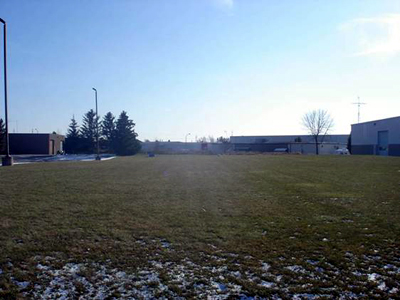
I put the sketchbook aside and opened a tin of Sardines.
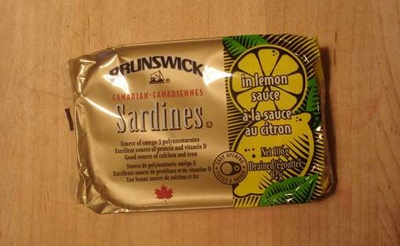
Brunswick Sardines in lemon sauce
Sardines are self contained. You don't need to cook them. They cost $0.99. Actually, I'd put them in the borderland between a hefty snack and a light meal. They also have the "good” kind of cholesterol, I'm told, if that's an issue for you.
Sometimes I buy all the different toppings they offer: lemon, mustard, tomato, jalapeno. Then I pull off all the wrapping papers and mix them up. That way it's a fun surprise, days later, when I open one up and don't know what exactly I'm getting.
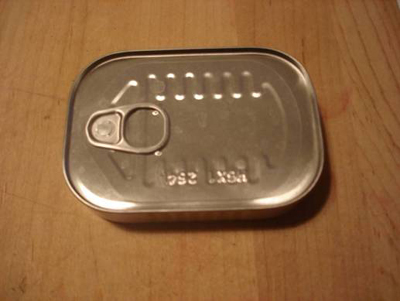
Unmarked mystery sardines
I must have missed the Martha Stewart segment on the easy and elegant way to prepare and enjoy sardines, so I'm going it alone here. First Problem: the smell is strong when you open them up and a lot of people don't like it.
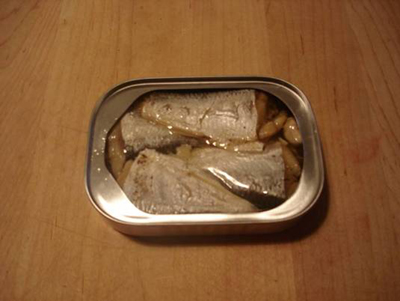
Open can of sardines, packed the way you would expect
(You can sure see where the expression packed like sardines comes from. Eh?) But OK, so it's better for an outdoor snack, which is how I do it.
Second and Major Problem: when you're done you have to sneak inside the washroom of a public building when no one's around and wash out the tin really carefully and then take it home and put it in your metal recycling, but I still find that less aggravating than cleaning out the plastic peanut butter container so you can put it in plastic recycling
.I just absolutely hate that. I leave the peanut butter container full of warm water next to the sink, to soften it up, but I still end up having to wipe it out with a dishcloth that's now all mucky and hideous, and I don't want to mix it with the other more conventionally soiled rags and cloths and towels and such because it will make them mucky and hideous.
So by comparison the sardine container isn't so bad.
I particularly enjoy sardines on a rice cake. While I know that the vogue for tall food is so 'last-decade', I can't resist arranging them in an elegant streamlined form atop the rice cake, which forms a kind of plinth -
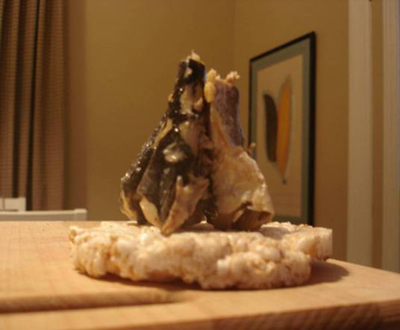
Sardines arranged in a kind of plinth on a rice cake
- emulating the geometric modernism of, say, Brancusi.

Constantin Brancusi, Male Torso (Photo Credit: Cleveland Art)
Then I usually just knock them over onto the rice cake and eat the whole mess of them. Yummmm!
So, I went back to the art store and bought charcoal, which wasn't any better because I didn't know you needed a fixing agent for after you use charcoal or else it rubs off on the facing page, which it did. Soon my sketchbook looked like I had rubbed the entire thing in dirt.
Honestly, I don't know why anyone would decide to be a visual artist. All those trips back to the store - I'd be worn out if I did it for a living. I mean with writing, once you buy your computer you're set.
Then I discovered ink. Makes a hard, fairly even line. Dries quickly. While I make no claims for these pictures as art, they at least bear some resemblance to what they depict.
Those of you who regularly walk this area will immediately recognize this view -
![Ink sketch of A[BP] approach Ink sketch of A[BP] approach](/static/images/ancaster_business_13.jpg)
Ink sketch of A[BP] approach
- as a particularly stunning approach to the A[BP], which I enjoyed every time I skidded down the escarpment just South of The Egg and I to retrieve my daughter from the HGA.
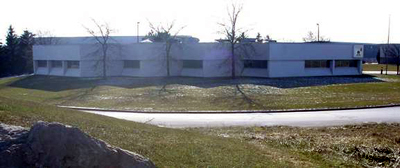
Photo of same approach
You probably won't recognize the view below -
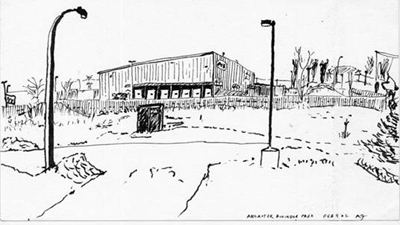
Ink sketch of another view
Here's why: between the parking lot I was sitting in, and the loading dock I was facing when I drew this picture, they've erected a particularly lyrical addition to the A[BP].
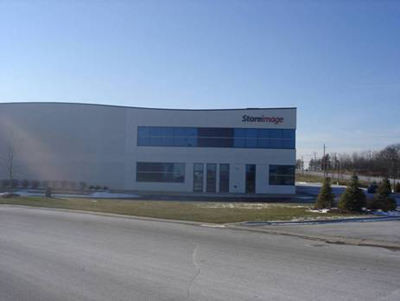
Jarring sensuality in a curving roof
The curve of the roof evokes a jarring sensuality, compared with the otherwise stiff rectangles around it. It summons of the curve of a woman's arm, as could be depicted by any number of French Masters. I've chosen a detail of a Matisse Odalisque almost at random, but I know you'll make your own connections.

Henri Matisse, Odalisque in a Gauze Skirt. 1929. Black and white lithograph. (Photo Credit: ABC Gallery)
You can see why, if I were an entrepreneur looking for rental space, I wouldn't use any space overlooking this building. It would, for sure, radically impinge on the productivity of any heterosexual males I had on staff.
My daughter no longer does gymnastics at the HGA, but I have been back many times over the years. Why? Probably because I'm both compelled and alarmed by borderlands. The outer limits of the A[BP] constitutes a western edge of the Golden Horseshoe. There is urban sprawl, and then, abruptly, there isn't.
My experiences and comfort zones are urban. Of course, people and a culture exist beyond this point, but I know nothing about them, beyond the fact that their culture is sparsely populated, allowing them what would, for me, be a terrifying amount of personal space.
I can't even conceive what people with such freedom might get up to. Gazing from the edge of A[BP] outwards recently, out beyond the power lines which are my last reference point, I was forced to imagine the lifestyle of people who lived out there.
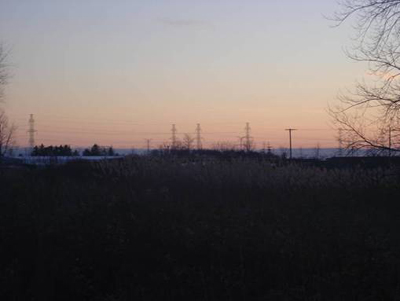
The edge of the urban realm
My sense of hinterlands is informed by the singular vision of Odd Nerdrum, the Icelandic painter, whose works depict behaviours for which I have no reference
.
Nerdrum, Man imitating cloud, oil on canvas, 1990 (Photo Credit: Nerdrum)
It is a world in which justice and retribution are meted out with ritual savagery and received with stoic resignation.
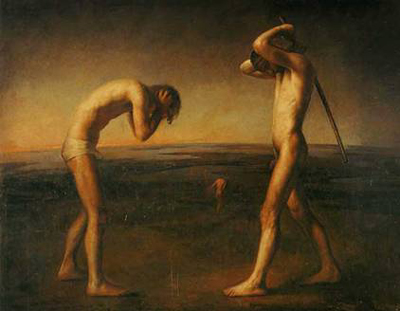
Nerdrum, Iron Law, Oil on Canvas, 1994 (Photo Credit: Nerdrum)
Eek! I am not ready to explore what things might be beyond city limits.
* * *
On a sunny day in mid December I returned to the A[BP]with my friend M. We met at his new house and I snapped this translucent view from his living room.
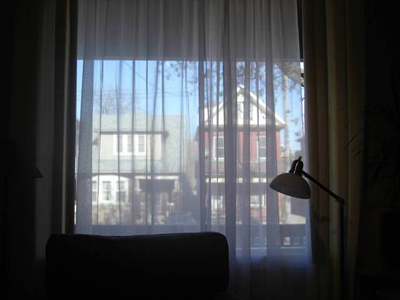
M.'s living room
Not the best picture, I realize, shooting out into sunny midday from an unlit room. It comes across here as the kind home that's kept dark and veiled, furnished by detritus of previous tenants, whose squalor the occupants barely notice because they're so busy doing needle drugs.
I assure you this isn't the case at all. It's a lovely home.
So, M. and I drove out and parked at Tradewind and Sandhill.
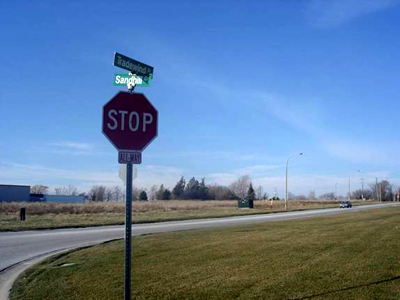
Tradewind and Sandhill
It's still quite undeveloped, as you can see. The potential is infinite. Imagine the day when it's fully built up with both businesses and residences: condos a guy like me couldn't even stand gaping at without being moved along by security; a place so stylish and beautiful it becomes iconic of where we'd all live if we could afford to, and maybe even a location we get tired of seeing as a Hollywood movie setting.
Screenwriter [Shaggy; unshaven; jeans; carefully rumpled sports jacket over a black T-shirt] Thanks for making time. It's an honour Mr. -
Producer: Save it punk. You got 90 seconds.
Screenwriter: It's a love story. The setting is ... .Northern -
Producer: Uh-huh. Continue to tell me why I'm not sorry I'm wasting time with you.
Screenwriter: You'll love the opening shot. The woman ... I'm thinking ... nnnn ... Halle Berry? Someone like that. A little bit exotic. She steps out of her apartment. Canada. Southern Ontario. Tradewind and Sandhill -that's actually the title I -
Producer: [reaching for a stack of screenplays he can barely lift and thunking it on his desk.] See this?! I could paper my office - and you've noticed it's a big office - with the romance movies that take place at Tradewind and Sandhill. Jesus. Have any of you kids been up there? It's a big country ...
Screenwriter: Doesn't have to be. Doesn't have to be. Alternately I was think Yonge and Eglinton. Maaaaybe even West End Vancouver - .
Producer: What the hell happened to domestic locations. Why the hell can't we bring the industry home to -
Screenwriter: You read my mind. I've got something on the back burner. More gritty. More street. She steps out of a loft on Lafayette and Great Jones Street. I'm thinking someone earthy for this. Maybe Kate Winslet. And she -
Producer: Beat it. You bore me.
But right now of course Tradewind and Sandhill is just a place for M. and me to start a walking tour. Parking isn't a problem.
We were struck immediately by this sign:
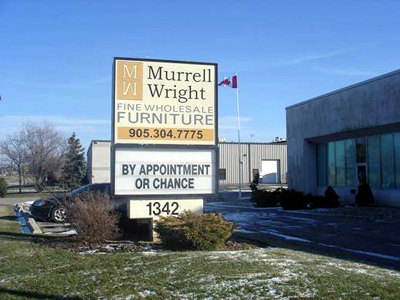
Murrell Wright Fine Wholesale Furniture: By Appointment or Chance
Perhaps I'm overlooking possibilities, but what, really, would be the likelihood of an unplanned walk-in. You'd have to have seen the sign from Wilson street, say to yourself; "Cool. I'm looking for some new furniture" and navigate the complex set of turns onto Sandhill, wind around park, and then hunt for a customer entrance.
Salesman: Good-day sir.
Customer: [eyes adjusting to the interior light, and almost knocking over an end-table]. Oh ... oh Hi.
Salesman: Here, let me move that for you. Did you have an appointment with ... with.. [eyebrows rising expectantly]
Customer: Um ... no actually. Is ... is that OK..? should I ... ?
Salesman: No...no no ... it's no trouble whatsoever. But, can I ask, if you don't mind ... How did you came to find our business. Was it an ad? Word of word of mouth, or the merest chance -
Customer: Oh. Chance. Total chance. I was just heading out to go bowling and I saw your sign.
Salesman: I see. And what was it you were looking for?
Customer: Oh ... Stools man ... stools.
Salesman: I'm sorry ... ?
Customer: Yeah. I'm building a bar in my basement. And I need a bunch of really tall stools! [gesturing the height with a flat hand].
Salesman: I'm sorry, I'm afraid we can't help you.
We didn't take pictures for very long before M. and I ended up at -you guessed it -The Egg and I -for a snack. We neither of us eat like this very often, but it is a compelling place. Charmingly last-century.
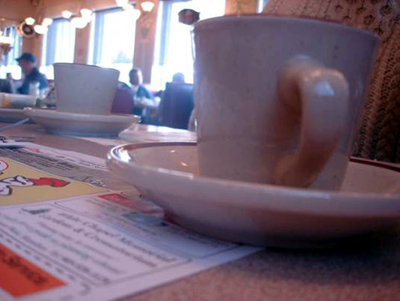
There is a small army of wait-staff, all female. Some of whose sole purpose seems to be to move hither and thither with coffee-pots and ensure that cups are never empty.
I wanted to order something that would come close to the depiction in the menu.
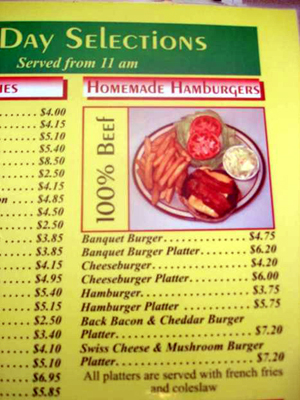
100% Beef Homemade Hamburger depicted on menu
Sure enough, it came very close indeed.
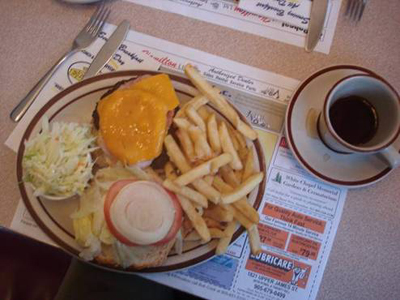
Actual 100% Beef Homemade Hamburger
I must say, I don't understand the tradition of presenting coleslaw in a disposable, polystyrene foam container. It don't imagine these things are recyclable in any practical way. There must be people who are offended by the thought of the cabbage sitting at plate level and nestling into their hamburger, even though having French Fries touch the hamburger causes no anxiety.
Perhaps there is joy, for some, in being able to separate the coleslaw as a distinct entity and eat it with polystyrene foam vessel in hand, reducing the travel distance by fork from container to head. It might just be.
Myself, if I order this meal again I'll probably ask that it be placed directly on the plate and just see what happens. I hope I'm not being picayune her. I have no credentials as a restaurant reviewer and don't pretend to, but I will add that the coleslaw was really quite good.
Our light was dying. We had one final stop on our journey. For the number of times I'd walked from The Egg and I to Maple Farms Motel, I'd never noticed this small graveyard, sheltered in trees.
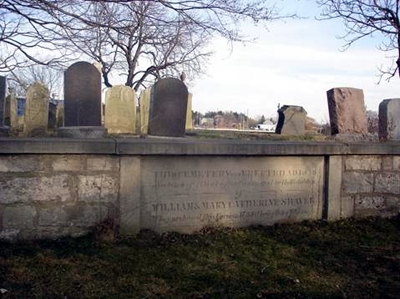
A small graveyard, sheltered in trees
It's almost directly across from Maple Farms motel, in the acute angle of the Wilson/Garner intersection slightly to the East of the gas pad/strip mall complex. Self contained. Striking for its hidden-ness in such a busy location.
I recommend you find it and linger there during your A[BP] tour. I've come across these incongruous burial grounds before. They're everywhere in this overdeveloped region. I've even heard talk of them curled within on-ramps to 400 series highways.
We will bulldoze house, barns, Churches, evict low-income tenants at minimum notice for the development of highways and business parks, but the persistence of the dead is a stumbling block. They may care the least, but are the entities most successful at digging in their heels and remaining where they have been for so long.
The readable dates on the stones were from the mid-19th century. I emphasize readable, because the elements have, in less than two centuries, done a lot of work against chiseled memorials and much information on these stones is gone. Like the shattered effigy of King Ozymandias in Shelly's Sonnet, even families like this one (who I assume had reasonable wealth and prominence in the community), are ineffective in shoring their legacy against the entropy of time.
M. snapped this photo of me as I stood on the stone wall enclosing the raised burial ground.
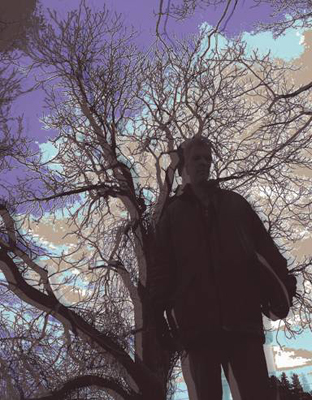
The author (Photo Credit: Mark Knackstedt)
I don't know what he did to it in Photoshop, but it reminds me of those comic books I used to see in my youth, in which an image was overlapped in different colours, and the magazine supplied a pair of cardboard glasses with cellophane lenses of different colours, and wearing them allowed you to see the image in three dimensions.
Somewhere out there there's a set of beige and navy glasses that allow you to do that with this picture. (Again: if you can imagine it, you can buy it online. I should have asked M. if he had a pair.) When you get them, I will be flattened but distinct and measurably in front of the creepy tree, which will in turn be measurably in front of the distant clouds.
Evocative as the picture is, it doesn't depict me with too much clarity. For instance it looks like I'm holding a skateboard and I'm about to cruise the concrete perimeter of the graveyard, clacking nimbly its concrete edge, adept at such flourishes as Caspar flips and Frontside 180s. But Dude, I don't have that kind of a skill set. I just holding the vinyl portfolio that contains my sketching gear.
I can, however, tell you what I was thinking as M. took this picture. I was recalling the closing lines Philip Larkin's poem Church Going. The poem's speaker is an urbane, educated Englishman. If not an outright atheist, he clearly lives a secular life. He is not a church goer. Yet passing a church, he stops on a whim to enter the shell of a waning tradition.
He begins his visit by silently making fun of the Church's rituals and holy relics. His very insistence in mocking them proves they hold an unexpected power over him. Puzzled by the emotions that things inside and outside the building are eliciting, he examines his relation to them. They force a seriousness on his thoughts; one he hadn't expected.
The final and incontrovertible importance of the building - which he feels will endure even beyond the belief system which created it - lies in the gravesites around it.
A serious house on serious earth it is,
In whose blent air all our compulsions meet,
Are recognised, and robed as destinies.
And that much never can be obsolete,
Since someone will forever be surprising
A hunger in himself to be more serious,
And gravitating with it to this ground,
Which, he once heard, was proper to grow wise in,
If only that so many dead lie round.
By peter (anonymous) | Posted February 16, 2007 at 18:25:19
I've lived in Ancaster for a while now, raised my daughters up through the developing years, including taking them to their classes in gymnastics, singing, art, baseball and music...and your story says to me more about us fathers desperately seaking any form of creative stimulus during those times and is hilarious...do you write for a living? ...or just for fun...like this article certainly is.
email me at peter@mccluskeydesign.com if you want to talk more about life and Ancaster and our kids growing up here.
Peter McCluskey (Anonymously of course)
You must be logged in to comment.
There are no upcoming events right now.
Why not post one?